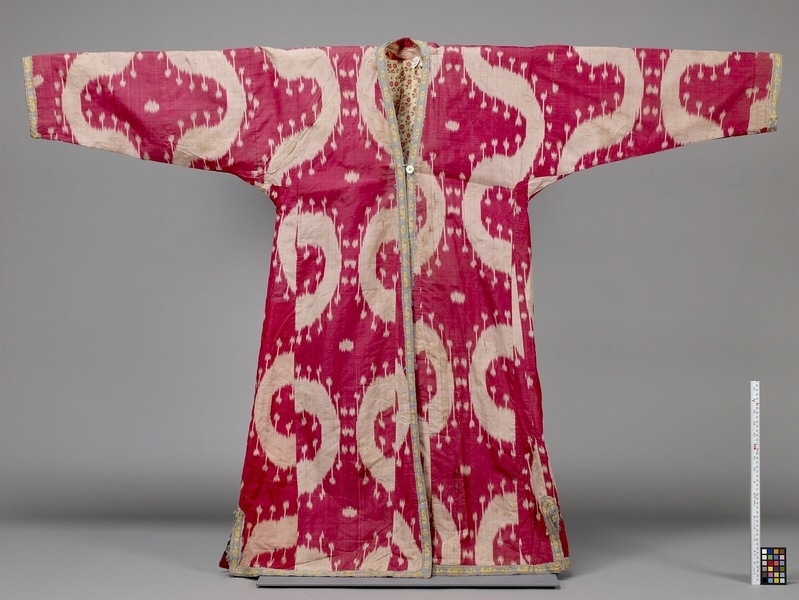Coat Item Number: 1201/4 from the MOA: University of British Columbia



Description
Man’s silk ikat long-sleeved robe. The silk taffeta textile is boldly patterned in red and off-white. A-line silhouette. The front opening, cuffs, hem and vents are edged with light blue, yellow and tan geometrically patterned braid. The silk ikat is hand quilted onto a lining of off-white machine printed cotton textile with small red and brown floral pattern, with a thin cotton batting between the layers. A shell button and loop fastening have been added at centre front, at chest level. All edges are faced with red and yellow silk ikat textile, cut on the bias.
History Of Use
Silk robes were worn by privileged people, either singly or layered with other robes. Photographs show silk robes being worn for everyday life, but some published sources indicate they were worn for celebrations and grand occasions. Its large size would indicate that this is a man’s robe. Men’s robes were made in the bazaar by the merchants who sold the textiles, while women’s robes were generally made by women in the home from textiles purchased at the market. The sleeves are long enough to cover the hands; it was considered rude to show the hands. The front edges of the robe overlap only from the waist down at centre front, leaving a gap that allows the wearer to show other garments that are layered underneath, a symbol of wealth. The button and loop closure at the centre front were probably added in the recent past, since Central Asian ikat robes do not traditionally have button and loop closures at the centre front. Pure silk garments could only be worn by individuals of high rank. Others of lower ranks could wear textiles with a silk warp and cotton weft. The production of ikat silks, which reached its peak in the 19c and declined rapidly in the early 20c, was a commercial venture, carried out primarily in urban centers, such as Bukhara, Samarkand and Marghilan in the Ferghana Valley by various ethnic groups, such as Uzbeks, Turkmen and Tajiks. Woven silks were widely distributed throughout Central Asia and were sold in local bazaars. The varied tasks required in the complex dyeing and weaving of ikat textiles were traditionally assigned to specific ethnic groups. For instance, Jews traditionally were assigned the task of ‘cold dyeing’ with indigo. The cultivation of silk was women’s work, done in the home. Dyeing and weaving were done by men; women could not work outside the home. The lives of Central Asian women therefore centred around the home, where colourful, lavish textiles played a major role in the rituals of daily life. The printed cotton textiles used to line this piece was undoubtedly produced in Russia, where there was a flourishing industry that produced printed textiles for the Central Asian market.
Iconographic Meaning
Patterns on the robes were drawn from natural sources, i.e., plants and animals, and varied according to taste and fashion.
Narrative
Collected by Alan Davidson in Kabul, Afghanistan, in 1976. Purchased by MOA in 1987, when Mr. Davidson’s shop, Terlingua, in Calgary, closed and he liquidated his stock.
Item History
- Made in Uzbekistan ?
- Collected in Mazar-i-Sharif, Balkh, Afghanistan during 1976
- Owned by Alan Davidson before February 24, 1987
- Received from Alan Davidson (Seller), Ruth Read Bequest (Funding source) and Museum of Anthropology Shop Volunteers (Funding source) on February 24, 1987
What
- Name
- Coat
- Identification Number
- 1201/4
- Type of Item
- coat
- Material
- silk fibre, dye, cotton fibre and shell
- Manufacturing Technique
- warp face ikat
- Overall
- height 124.7 cm, width 181.4 cm
Who
- Culture
- Uzbek ?
- Previous Owner
- Alan Davidson
- Received from
- Alan Davidson (Seller), Ruth Read Bequest (Funding source) and Museum of Anthropology Shop Volunteers (Funding source)
Where
- Holding Institution
- MOA: University of British Columbia
- Made in
- Uzbekistan ?
- Collected in
- Mazar-i-Sharif, Balkh, Afghanistan
When
- Collection Date
- during 1976
- Ownership Date
- before February 24, 1987
- Acquisition Date
- on February 24, 1987
Other
- Item Classes
- textiles
- Condition
- fair
- Accession Number
- 1201/0004